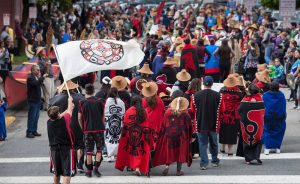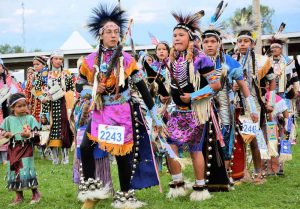Cheyenne flutes
Historically, the Cheyenne flute was only made and played by men. To make a flute, the man first needed to find a straight cedar branch of suitable shape and dimensions. The branch was then cut, and tied with dried buckskin thong. Five or six holes were drilled in the branch.
There are also examples of Cheyenne men making flutes from the leg bone of an elk instead of using cedar.
In Cheyenne culture, there is a link between flute playing and the wolves, possibly due to how wolfs and dogs can chime in with howling when they hear a flute being played.
The Cheyenne courting flute
The Cheyenne courting flute was associated with the wooing of a woman for marriage. In traditional Northern Cheyenne culture, a man wishing to marry would either make a flute himself or enlist the help of a tribal flute maker. The man would bring his flute to a quiet area and play a love song, hoping to attract his beloved.
A Cheyenne courting flute would often showcase a bull elk, and carvings of the sun and the moon, to honor the elk for food, shelter and clothing, and the sun and the moon for the gifts of the day and night.
Origin myth of the flute
In Cheyenne tradition, the flute is a gift from Mother Nature. There is a legend that explains how the first flute was given to a young boy from the Great Spirit.
In this story, a young boy had gotten lost and was wandering around alone, deep in the forest. The Great Spirit saw him and felt sorry for him, and sent him a small bird from the heavens to keep him company. The boy had sat down to rest in the shadow of a large tree, and the bird landed on one of its hollow branches. The brisk nothern wind blew through the hollow branch, producing a sound the boy had never heard before. Surprised, he looked up, and noticed the bird. The bird started pecking holes in the hollow branch, and for each new hole the bird made, the pitch changed.
The boy realized that the mesmerizing sound was coming from the branch and that it was a gift to him from the Great Spirit. He carefully began to climb the tree, and when he had reached the dead and hollow branch, he gently broke it off. When he blew into it, just as the northern wind had done, he heard the beautiful sound again. When the boy eventually found his people again, he showed them the flute and told them about the wonderful gift from the Great Spirit.
The story about Twin and his flute
In this Cheyenne story, a man named Twin is gifted a flute from a bull elk.
Twin was returning from a hunting trip in Powder River Country. He had made a kill, and when the day was coming to an end, he made a camp under a sand rock wall. He unloaded the meat from his horse and left the horse to graze.
Suddenly, Twin heard an elk bugle in the distance. The bugling was coming closer and closer, until it stopped. After not hearing any bugling for a while, Twin instead began hearing footsteps above him and then heard a voice telling him to look for an elk bone flute wrapped in sage. The voice told him that the flute was a gift from an elk and the Twin should bring it home. Soon, there was silence again, and then Twin heard the bugling once more from a distance. In the morning light, Twin found an elk bone flute wrapped in sage laying on the ground, and he obeyd the voice and brought it home.
When Twin died, the flute was passed on to his relatives, and one of them took it and placed it under a pile of rocks. According to Cheyenne legend, it might still be there, hidden somewhere along a bluff on the eastern side of Otter Creek.
The Cheyenne flute – a surviving piece of Cheyenne culture
For her book “Music in the Westward Expansion. Songs of Heart and Place on the American Frontier” (2022), Montana-born musician and author Laura Dean met up with JD Old Mouse, a Northern Cheyenne who still make and play traditional Chayenne flutes.
JD Old Mouse, who lives in Busby, MT on the Northern Cheyenne Reservation, belongs to a long line of Cheyenne flute makers. Turkey Legs, who lived near Fort Keugh in the late 1800s, was a skilled flute maker, and he passed his knowledge to Grover Wolf Voice, who in turn thought Douglas Blackbear Glenmore – the grandfather of JD Old Mouse.
The Cheyenne flute is still an integral part of Cheyenne culture and JD frequently plays the flute at weddings, funerals and other special occasions, and in the schools.
Traditionally, the flute was only played by men, but nowadays JD Old Mouse is also making flutes for women, including those who are interested in playing the flute for educational or healing purposes.
If you are interested in learing more, there is a video on YouTube where JD Old Mouse plays the Cheyenne flute and talks about its cultural significance.
The Cheyenne / Tsitsistas
The Cheyenne, named Tsitsistas in their native language, is a Native American people indigenous to North America. Historical and archeological evidence traces their origins to the woodland culture in Minnesota, but by the 17th century, they had migrated to the plains of Colorado and Wyoming.
In the colonial era, the Cheyenne developed a reputation for being unusually brave and courageous. They fiercely resisted the westward expansion of European colonizers, engaging in numerous battles and wars. The Sand Creek Massacre and the Battle of Little Bighorn are notable events in Cheyenne history.
Today, there are two federally recognized Cheyenne tribes:
- The Northern Cheyenne Tribe of the Northern Cheyenne Indian Reservation (Cheyenne: Tsėhéstáno) in southeastern Montana.
- The Southern Cheyenne & Arapaho Tribes in western Oklahoma.
Culture and Traditions of the Cheyenne
The Cheyenne tribe’s story is a testament to resilience, adaptability, and heritage. This rich cultural tapestry, marked by distinct traditions, beliefs, and societal structures, offers an enlightening insight into the complexity of this indigenous North American culture. The culture of the Cheyenne is deeply rooted in the interconnectedness of the earth, the spirit world, and the community. The Sun Dance, an essential ritual, serves as a testament to this belief. It is a communal event held annually during the summer solstice, symbolizing life renewal, the harmonious relationship between humans and nature, and the connection with the higher spiritual realm.
The Cheyenne societal structure is comprised of military societies, medicine societies, and various age-grade societies. Each society has a specific role and purpose within the community, contributing to the overall order and functioning of the group.
The Cheyenne have a rich oral tradition. These stories, passed down through generations, serve as a repository of their history, values, and philosophical worldview. The tale of Sweet Medicine, a cultural hero who brought the sacred tribal laws and organizational structure, is an iconic example of this oral tradition.
Despite facing numerous challenges, including forced relocations and assimilation pressures, the Cheyenne has managed to preserve and evolve a lot of their cultural heritage. Many Cheyenne continue to practice their traditional rituals, maintain their language, and pass their stories to younger generations. As part of their resilience and adaptability, they have also embraced modernity, contributing to various fields, including politics, education, arts, and sports.
In recent years, Cheyenne educators have been proactive in revitalizing their language. The Cheyenne Language Immersion School in Montana is an initiative to foster language learning among younger members, thus ensuring the survival of their native tongue.
Cheyenne history and traditions are intertwined in many ways with the Bison bison, and a herd of bison (colloqially known as buffalo) has now been established by the Cheyenne and Arapaho Tribes for both cultural and food sovereignty purposes. In 2021, the number of buffalo was 530, including 13 reacently donated by the Denver Parks and Recreation to improve the genetic diversity of the herd.
This article was last updated on: June 6, 2024


